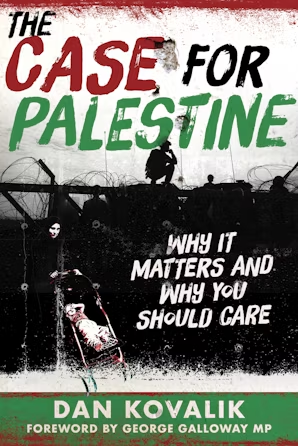Israel hasn’t just crossed the Biden administration’s pretend “red lines” in Gaza. With its massacre at Nuseirat refugee camp at the weekend, Israel drove a bulldozer through them.
On Saturday, an Israeli military operation to free four Israelis held captive by Hamas since its 7 October attack on Israel resulted in the killing of more than 270 Palestinians, many of them women and children.
The true death toll may never be known. Untold numbers of men, women and children are still under rubble from the bombardment, crushed to death, or trapped and suffocating, or expiring slowly from dehydration if they cannot be dug out in time.
Many hundreds more are suffering agonising injuries – should their wounds not kill them – in a situation where there are almost no medical facilities left after Israel’s destruction of hospitals and its mass kidnap of Palestinian medical personnel. Further, there are no drugs to treat the victims, given Israel’s months-long imposition of an aid blockade.
Israelis and American Jewish organisations – so ready to judge Palestinians for cheering attacks on Israel – celebrated the carnage caused in freeing the Israeli captives, who could have returned home months ago had Israel been ready to agree on a ceasefire.
Videos even show Israelis dancing in the street.
According to reports, the bloody Israeli operation in central Gaza may have killed three other captives, one of them possibly an American citizen.
In comments to the Haaretz newspaper published on Sunday, Louis Har, a hostage freed back in February, observed of his own captivity: “Our greatest fear was the IDF’s planes and the concern that they would bomb the building we were in.”
He added: “We weren’t worried that they’d [referring to Hamas] do something to us all of a sudden. We didn’t object to anything. So I wasn’t afraid they’d kill me.”
The Israeli media reported Israeli Defence Minister Yoav Gallant describing Saturday’s operation as “one of the most heroic and extraordinary operations I have witnessed over the course of 47 years serving in Israel’s defence establishment”.
The chief prosecutor of the International Criminal Court is currently seeking an arrest warrant for Gallant, as well as Prime Minister Benjamin Netanyahu, for war crimes and crimes against humanity. The charges include efforts to exterminate the people of Gaza through planned starvation.
Israel has been wrecking the established laws of war with abandon for more than eight months.
At least 37,000 Palestinians are known to have been killed so far in Gaza, though Palestinian officials lost the ability to properly count the dead many weeks ago following Israel’s relentless destruction of the enclave’s institutions and infrastructure.
Israel has additionally engineered a famine that, mostly out of view, is gradually starving Gaza’s population to death.
The International Court of Justice put Israel on trial for genocide back in January. Last month, it ordered an immediate halt to Israel’s attack on Gaza’s southern city of Rafah. Israel has responded to both judgments by intensifying its killing spree.
In a further indication of Israel’s sense of impunity, the rescue operation on Saturday involved yet another flagrant war crime.
Israel used a humanitarian aid truck – supposedly bringing relief to Gaza’s desperate population – as cover for its military operation. In international law, that is known as the crime of perfidy.
For months, Israel has been blocking aid to Gaza – part of its efforts to starve the population. It has also targeted aid workers, killing more than 250 of them since October.
But more specifically, Israel is waging a war on Unrwa, claiming without evidence that the UN’s main aid agency in Gaza is implicated in Hamas “terror” operations. It wants the UN, the international community’s last lifeline in Gaza against Israel’s wanton savagery, permanently gone.
By hiding its own soldiers in an aid truck, Israel made a mockery of its supposed “terrorism concerns” by doing exactly what it accuses Hamas of.
But Israel’s military action also dragged the aid effort – the only way to end Gaza’s famine – into the centre of the battlefield. Now Hamas has every reason to fear that aid workers are not what they seem; that they are really instruments of Israeli state terrorism.
In the circumstances, one might have assumed the Biden administration would be quick to condemn Israel’s actions and distance itself from the massacre.
Instead, Jake Sullivan, President Joe Biden’s national security adviser, was keen to take credit for the mass carnage – or what he termed a “daring operation”.
He admitted in an interview on Sunday that the US had offered assistance in the rescue operation, though he refused to clarify how. Other reports noted a supporting British role, too.
“The United States has been providing support to Israel for several months in its efforts to help identify the locations of hostages in Gaza and to support efforts to try to secure their rescue or recovery,” Sullivan told CNN.
Sullivan’s comments fuelled existing suspicions that such assistance extends far beyond providing intelligence and a steady supply of the bombs Israel has dropped on the tiny Gaza enclave over the past few months – more than the total that hit London, Dresden and Hamburg combined during the Second World War.
A Biden official disclosed to the Axios website that US soldiers belonging to a so-called American hostages unit had participated in the rescue operation that massacred Palestinian civilians.
Additionally, footage shows Washington’s floating pier as the backdrop for helicopters involved in the attack.
According to Axios, citing a U.S. administration official, the American hostages unit in Israel assisted in the release of the four Israeli captives in Gaza.
Footage published by an Israeli occupation soldier confirms Israel's use of the American temporary pier in central Gaza… pic.twitter.com/GJJp1ZSA7T
— Quds News Network (@QudsNen) June 8, 2024
The pier was ostensibly built off Gaza’s coast at huge cost – some $320m – and over two months to bypass Israel’s blocking of aid by land.
Observers argued at the time that it was not only an extraordinarily impractical and inefficient way to deliver aid but that there were likely to be hidden, nefarious motives behind its construction.
Its location, at the midpoint of Gaza’s coast, has bolstered Israel’s severing of the enclave into two, creating a land corridor that has effectively become a new border and from which Israel can launch raids into central Gaza like Saturday’s.
Those critics appear to have been proven right. The pier has barely functioned as an aid route since the first deliveries arrived in mid-May.
The pier soon broke apart, and its repair and return to operation was only announced on Friday.
Now the fact that it appears to have been pressed into immediate use as a beachhead for an operation that killed at least 270 Palestinians drags Washington even deeper into complicity with what the World Court has called a “plausible genocide”.
But like the use of the aid truck, it also means the Biden administration is joining Israel once again – after pulling its funding to Unrwa – in directly discrediting the aid operation in Gaza when it is needed most urgently.
That was the context for understanding the World Food Programme’s announcement on Sunday that it was halting the use of the pier for aid deliveries, citing “safety” concerns.
As ever, for western media and politicians – who have stood firmly against a ceasefire that could have brought the suffering of the Israeli captives and their families to an end months ago – Palestinian lives are quite literally worthless.
The German Chancellor Olaf Scholz thought it appropriate to describe the killing of 270-plus Palestinians in the freeing of the four Israelis as an “important sign of hope”, while the British Prime Minister Rishi Sunak expressed his “huge relief”. The appalling death toll went unmentioned.
Imagine describing in similarly positive terms an operation by Hamas that killed 270 Israelis to liberate a handful of the many hundreds of medical personnel kidnapped from Gaza by Israel in recent months and known to be held in a torture facility.
The London Times, meanwhile, breezily erased Saturday’s massacre of Palestinians by characterising the operation as a “surgical strike”.
Media outlets uniformly hailed the operation as a “success” and “daring”, as though the killing and maiming of around 1,000 Palestinians – and the serial war crimes Israel committed in the process – need not be factored in.
BBC News’ main report on Saturday night breathlessly focused on the celebrations of the families of the freed captives, treating the massacre of Palestinians as an afterthought. The programme stressed that the death toll was “disputed” – though not mentioning that, as ever, it was Israel doing the disputing.
The reality is that the savage “rescue” operation would have been entirely unnecessary had Netanyahu not been so determined to drag his feet on negotiating the captives’ release, and thereby avoid jail on corruption charges, and the US so fully indulgent of his procrastination.
It will also be very difficult to repeat such an operation, as Haaretz’s military correspondent Amos Harel noted at the weekend. Hamas will learn lessons, guarding the remaining captives even more closely, most likely underground in its tunnels.
The remaining captives’ return will “probably occur only as part of a deal that will require significant concessions”, he concluded.
Benny Gantz, the politician-general who helped oversee Israel’s eight-month slaughter in Gaza inside Netanyahu’s war cabinet and is widely described as a “moderate” in the West, resigned from the government on Sunday.
Although ostensibly the dispute is over how Israel will extricate itself from Gaza over the coming months, the more likely explanation is that Gantz wishes both to distance himself from Netanyahu as the Israeli prime minister faces possible arrest for crimes against humanity and to prepare for elections to take his place.
The Pentagon and the Biden administration see Gantz as their man. Having him out of the government may give them additional leverage over Netanyahu in the run-up to a US presidential election in November in which Donald Trump will be actively trying to cosy up to the Israeli prime minister.
The focus on Israeli politicking – rather than US complicity in the Nuseirat massacre – will doubtless provide a welcome distraction, too, as US Secretary of State Antony Blinken tours the region. He will once again wish to be seen rallying support for a ceasefire plan that is supposed to see the Israeli captives released – a plan Netanyahu will be determined, once again, to stymie.
Blinken’s efforts are likely to be even more hopeless in the immediate wake of the Biden administration’s all-too-visible involvement in the killing of hundreds of Palestinians.
Washington’s claim to be an “honest broker” looks to everyone – apart from the reliably obedient western political and media class – as even more derisory than usual.
The real question is whether Blinken’s serial diplomatic failures in ending the slaughter in Gaza are a bug or a feature.
The stark contradiction in Washington’s position towards Gaza was exposed last week during a press conference with State Department spokesman Matthew Miller.
He suggested that the aim of Israel and the US was to persuade Hamas to dissolve itself – presumably by some form of surrender – in return for a ceasefire. The group had an incentive to do so, said Miller, “because they don’t want to see continued conflict, continued Palestinian people dying. They don’t want to see war in Gaza.”
Even the usually compliant western press corps were taken aback by Miller’s implication that a crime against humanity – the mass killing of Palestinians, such as took place at Nuseirat camp on Saturday – was viewed in Washington as leverage to be exercised over Hamas.
But more likely, the seeming contradiction was simply symptomatic of the logical entanglements resulting from Washington’s efforts to deflect from the real goal: buying Israel more time to do what it is so well advanced doing already.
Israel needs to finish pulverising Gaza, making it permanently uninhabitable, so that the population will be faced with a stark dilemma: remain and die, or leave by any means possible.
The same US “humanitarian pier” that was pressed into service for Saturday’s massacre may soon be the “humanitarian pier” that serves as the exit through which Gaza’s Palestinians are ethnically cleansed, shipped out of a death zone engineered by Israel.
• First published in Middle East Eye
The post The Day the West Defined “Success” as a Massacre of 270 Palestinians first appeared on Dissident Voice.This post was originally published on Dissident Voice.














